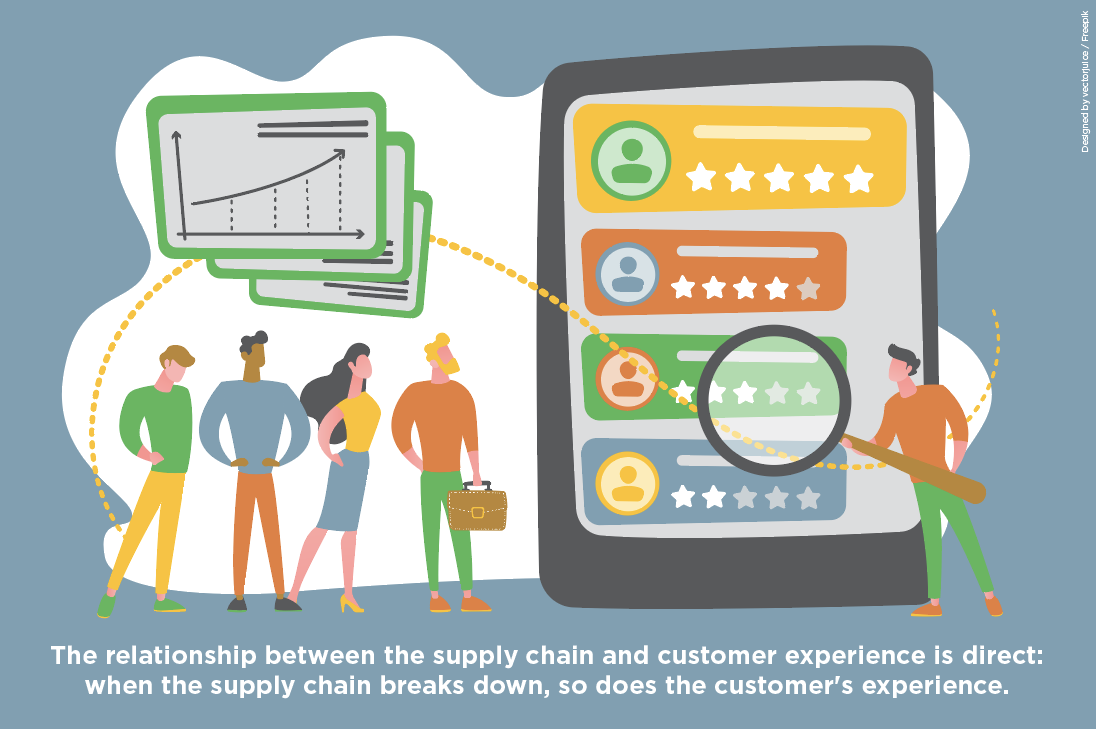From the moment a potential customer becomes aware of your company to when (or if) they decide to make another purchase, the efficiency and effectiveness of the supply chain directly impact the customer experience. Any disruptions that interfere with production, delivery, or feedback can influence future buying decisions and consumers’ brand loyalty. The relationship between the supply chain and customer experience is direct: when the supply chain breaks down, so does the customer’s experience.
Let’s examine various ways the supply chain and the customer experience are interrelated.
Heightened expectations — and pressure
A classic example is when customers wait for online orders to arrive. In an era of two-day, one-day, and even same-day delivery, buyers have very high expectations about getting their purchases in a timely fashion. For a variety of reasons related to the health of the supply chain, what they buy may show up after they expect it to. According to a poll conducted by Descartes, nearly three-quarters of consumers surveyed (73%) said they had experienced some kind of delivery issue within the last three months, including orders arriving late. More than 26% of respondents said the product came “much later than expected.”
The inconvenience of these experiences can have lasting repercussions on customer loyalty. Of those impacted by unsatisfactory delivery, about one in four (23%) said they have not ordered from the company since. And 21% indicated they lost trust in the retailer, while 16% told people they knew to avoid buying from the company. In such scenarios, it’s clear that when the supply chain fails to deliver, the customer experience suffers.
“Good enough” isn’t good enough
The customer experience can also take a hit when the merchandise consumers buy is defective, wrong, or does not fit. According to Descartes, 12% of customers who had an item delivered to them said what they received was different from what they had ordered. This past holiday season, for example, UPS processed more than 60 million returns between Nov. 14, 2022, and Jan. 22, 2023, according to estimates from the company. Of those customers who made a return, more than 20% did so before Dec. 25, complicating whether their purchase would make it back to them in time for the holiday.
A reliable and consistent supply chain is about more than just ensuring enough supply of a given item based on demand or that it arrives in the quoted window. It is also about quality assurance: determining that the order is correct and free of damage. When those expectations are not met, the customer experience suffers.

Rising costs bring value into focus
Another drag on the supply chain, as well as the customer experience, is inflation. According to the most recent Consumer Price Index (CPI) released by the Department of Labor, which tracks the rate at which prices for common goods are climbing relative to last year, the CPI rose 6.4% in January (unadjusted). While inflation has cooled off slightly, Americans still cite it as one of the top problems affecting the nation, based on recent Gallup polling data.
When the cost of living rises as much as it has, budget-minded consumers are often forced to re-evaluate how they spend their money. They must evaluate their purchases based on what they need to have and what they can live without. Inflation can also cause buyers to use different suppliers if competitors sell something similar for less. These changes in consumer behavior can create uncertainty in the supply chain as businesses try to anticipate changes in demand and adjust their production accordingly. However, a lower price point may ultimately lead to the loss of customers if the supplier switches to using lower-quality raw materials to save on manufacturing costs.
Much like managing an organization’s supply chain, creating an ideal customer experience is an imperfect science. But you can strengthen both by honing your approach to the post-purchase customer experience, i.e., all customer interactions and impressions with your company after the sale. The keys to success are found in the “Five C’s,” according to SupplyChainBrain:
- Communication: Thoughtful, proactive communication is essential. If an item may not arrive on time, customers must be informed of this possibility before it occurs.
- Consistency: There should be no surprises for customers concerning each buying experience. Customers’ ability to deliver feedback — or change their orders — should remain the same every time and consistently leverage the right processes and technologies.
- Costs: Returns and the costs that result from them are impossible to avoid entirely. But you can curb them by digitizing the returns process. Instead of placing a return slip in each order, digitizing returns makes the process more seamless by increasing visibility and making it easier to deny returns that go against company policy.
- Convenience: Customers love options, especially after making a purchase. The more you can give them — such as offering home delivery, in-store pickup, or curbside pickup — the happier they tend to be.
- Conservation: Sustainability is not only crucial to the environment — it is essential to consumers, some of whom are willing to pay more for goods and services from companies that adopt sustainable practices in their supply chain, their workplace, or their investments.
From shorter wait times at the nation’s shipping ports to fewer “out of stock” signs at big-box retailers, supply chains and customer experiences are much better today than this time last year. While conditions have improved, they are still not at “pre-COVID” levels. By preparing for supply chain disruptions and anticipating customer experience issues before they happen, organizations can get back to some semblance of normality.
Regardless of your supply chain and customer experience priorities, Inspirage has the experience, solutions, and expertise to help you achieve operational excellence across your organization. Contact us today to learn more.